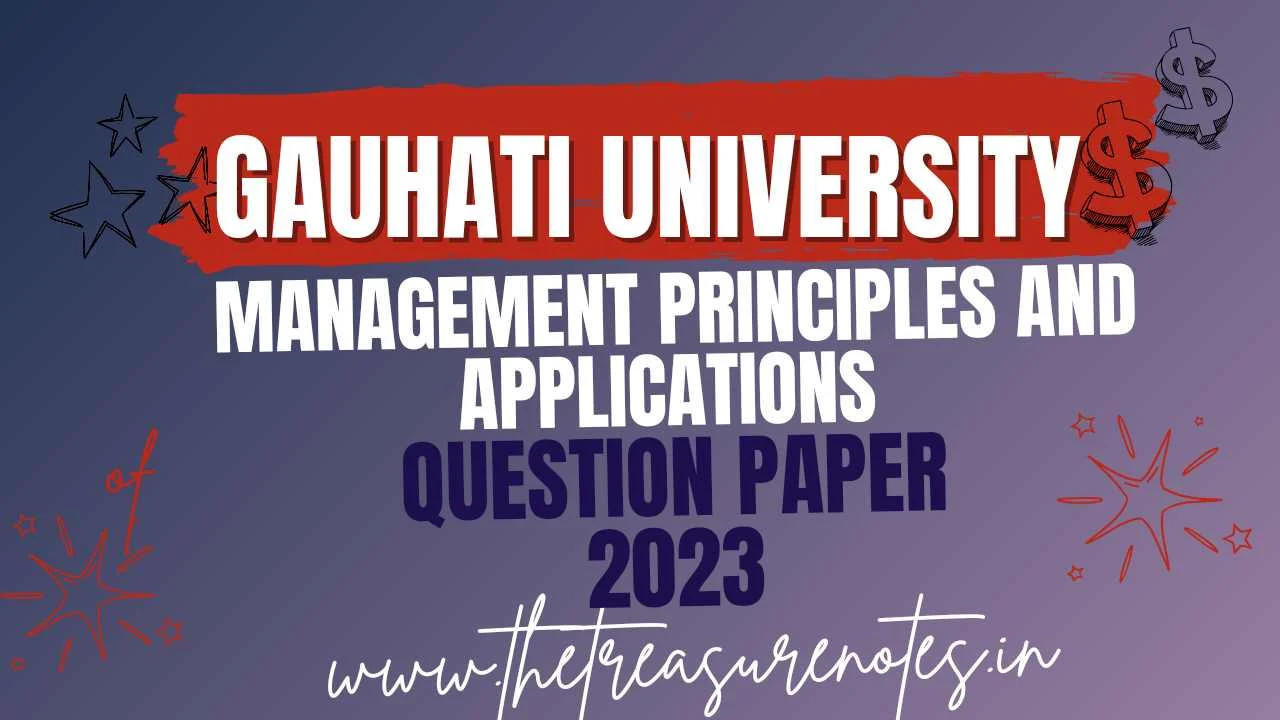In this Post we have shared Gauhati University Bcom 3rd Sem Management Principles and Applications Question Paper 2023 CBCS Pettern Now Very Helpful for FYUGP NEP 2nd Sem Students. This question paper is now highly relevant for Gauhati University FYUGP NEP GU B.Com 2nd Semester Principles and Practice of Management Question Paper 2023, as the syllabus for both patterns is quite similar. We recommend reading this question paper thoroughly for better preparation. Which Can be Very Useful For Your GU B.Com 3rd Semester Sessional or Final Semester Examination. GU B.com 3rd Management Principles and Applications Question paper 2023 in PDF Gauhati University.
Guwahati University BCom 3rd semester Management Principles and Applications question paper 2023
4 (Sem-3/CBCS) MPA
2023
COMMERCE
(Honours Core)
Paper: COM-HC-3036
(Management Principles and Applications)
Full Marks: 80
Time: Three hours
The figures in the margin indicate full marks for the questions.
1. Choose the correct answers to the following questions: 1×5=5
(i) Henry Fayol and F. W. Tailor belong to which of the following schools of management?
A. Neo-classical
B. Modern School
C Classical School
D. Early Perspective
(ii) As we go higher up on the management hierarchy the scope of authority:
A. Increases
B. Decreases
C. Remains same
D. None of the above
(iii) When recruitment is done through Linkedin, Twitter, and Facebook is known as
A. media recruiting
B. external recruiting
C. social recruiting
D. internal recruiting
(ιν) is the process of influencing the behaviour of people by making them strive voluntarily.
A. Supervision
B. Communication
C. Leadership
D. Motivation
(v) Which of the following is not a principle of Fayol's Fourteen Principles of Management?
A. Division of Work
B. Harmony, not discord
C. Discipline
D. Unity of Command
2. State whether the following statements are true or false : 1×5=5
(i) "The length of two sides of a triangle when added is always higher than the length of the third side" is a principle because there is a cause-and-effect relationship.
(ii) A plan to carry out a course of action that is not likely to be repeated in the future is known as a Single-use plan.
(iii) Chester Barnard is associated with the development of "Theory X."
(iv) Interest rates, inflation rates, and stock market indexes are examples of political environments.
(v) Management is a goal-oriented and continuous process.
3. Answer the question in brief: 2×5=10
(i) "Management is a Social Science"-Give two justifications.
(ii) "Jewel is the owner of a printing press. The size of his organization has increased during the recent past. Several workers work in his organization. The organization is considered good and has earned a lot of reputation in the market. However, when it comes to making key decisions related to organizational activities, he never consider the opinions of his subordinates. Even though the size of the organization has increased he tries to make all the key decisions on his own." Which principle of Fayol has been violated by Jewel? Justify.
(iii) Write a brief note on "On-the-Job" training.
(iv) Write the steps of controlling.
(v) List out the hierarchical needs as mentioned by Maslow.
4. Write short answers to the questions given below (any four)
5×4=20
(i) "Coordination is the essence of Management"-Discuss.
(ii) Describe the Delphi technique of decision-making.
(ii) Explain five features of management.
(iv) What are the problems generally faced in the process of Delegation of Authority ?
(v) Describe how the political and legal environment influences the business enterprises.
(vi) Explain the qualities of a good leader.
5. Answer the following questions: (any four) 10×4=40
(i) Explain the 4 rounds of studies. conducted in the Hawthorne Experiment. What are the major conclusions of the Hawthorne Experiment ? 6+4=10
(ii) Define Planning. Explain the steps involved in the Planning Process. 2+8=10
(iii) Explain the process of Organising. Also, describe the factors determining the Span of Management. 5+5=10
(iv) Critically examine Herberg's Two Factor Theory of Motivation. Are there any similarities between the theory and Maslow's Need Hierarchy Theory of Motivation? 8+2=10
(v) Discuss the features of decision- making. What are the steps involved in the decision-making process? -Explain. 5+5=10
(vi) Discuss the importance of communication in a business organization. Differentiate between formal and informal communication. 5+5=10
(vii) Critically examine Taylor's contributions to management science.
(viii) Explain the concept of Break-even Analysis. State the merits and limitations of Break-even Analysis. 4+6=10
-0000-

